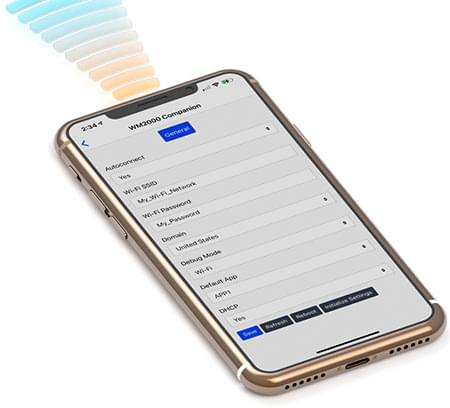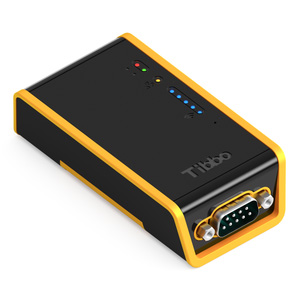The WS1102 is a compact Tibbo BASIC/C-programmable wireless controller equipped with an RS232/422/485 serial port.
The product targets serial-over-IP (SoI) and serial control applications.
This cloud-native device incorporates Wi-Fi (802.11a/b/g/n over 2.4GHz/5GHz) and Bluetooth Low Energy (BLE) interfaces that introduce several new features,
such as Wi-Fi auto-connects, wireless debugging, over-the-air (OTA) updates, and Transport Layer Security (TLS) support.
As a vendor-agnostic product, it can communicate with Microsoft Azure, Google Cloud, Amazon Web Services (AWS), and virtually any other cloud services provider.
There are eight LEDs on the device's front: green and red main status LEDs, a yellow access point association (link) LED,
and five blue LEDs, which can be used for Wi-Fi signal strength indication or other purposes. A buzzer is provided as well.
Each WS1102 is supplied with a DIN rail and wall mounting plates.
The WS1102 comes preloaded with a full-featured Serial-over-IP (SoI) application that turns the WS1102 into a powerful
serial-over-IP (SoI) device (a.k.a. a "device server").
A versatile Modbus Gateway application is also available.
Fast Deployment With the L.U.I.S. App
Anyone who has ever deployed a device on a target network knows that complications often come from silly little things, like the configuration of Wi-Fi parameters.
Enters the Loadable User Interface System (L.U.I.S.), our wireless configuration solution for Tibbo devices.
L.U.I.S. allows you to configure compatible Tibbo devices via their BLE interface.
The L.U.I.S. app (iOS, Android, web) automatically discovers nearby devices that support BLE configuration.
After you select a device to work with, the app loads configuration pages from the device itself.
Wi-Fi parameter configuration, IP selection, and many other settings are suddenly within easy and convenient reach!
It gets even better: The WS1102 also supports over-the-air firmware upgrades via BLE using our Tibbo Updater app (iOS, Android, web)!
Hardware
Specifications:
- Powered by Tibbo OS (TiOS)
- Stores up to two compiled Tibbo BASIC/C binaries (apps)(1)
- A Device Configuration Block (DCB)(2) defines which of the two apps normally runs on power-up
- Forced launch of APP0 through the MD button
- Wi-Fi interface (802.11a/b/g/n)
- Supported frequencies:
- 2.4GHz (2,412MHz ~ 2,462MHz)
- 5.0GHz band 1 (5,180MHz ~ 5,240MHz) and band 4 (5,745MHz ~ 5,825MHz)
- Standards compliance:
- FCC 15C and 15E Class B (FCC ID: XOJ-WS1102)
- EN 300 328 V2.2.2
- EN 301 893 V2.1.1
- EN IEC 62311
- Transmission distance: At least 100m in open space
- Supported Wi-Fi modes:
- Station
- Infrastructure (not available when using the SoI app)
- Security:
- Controlled via a simple-to-use, yet sophisticated API
- TLS1.2 with RSA-2048 cryptosystem(3)
- Optional "autoconnect" — automatic association with a designated Wi-Fi network as defined by the DCB(2)
- Optional debugging of Tibbo BASIC/C applications via the Wi-Fi interface(4)
- Bluetooth Low Energy (BLE 4.2)
- 2.4GHz (2,402MHz ~ 2,480MHz)
- Standards compliance:
- FCC 15C and 15E Class B (FCC ID: XOJ-WS1102)
- EN300 328 V2.2.2
- EN IEC 62311
- Transmission distance: 15m (tested) in open space
- Controlled via a simple-to-use, yet sophisticated API
- Can access the DCB via a new, integrated console(2)
- Internal high-gain Wi-Fi/BLE PCB antenna
- RS232/422/485 port on a DB9M connector
- Port modes are software-selectable
- TX, RX, RTS, CTS, DTR(5), and DSR(5) lines
- Baudrates of up to 921,600bps
- None/even/odd/mark/space parity modes
- 7 or 8 bits/character
- RTS/CTS and XON/XOFF flow control
- Built-in buzzer
- RTC (no backup battery)
- 58KB SRAM for Tibbo BASIC/C variables and data
- 4MB flash for code storage
- System files and TiOS occupy a combined 2,408KB
- 1,688KB available for storing up to two app binaries
- Additional 4MB flash for the hardened fault-tolerant file system
- 2048-byte EEPROM for data storage
- Eight LEDs
- Green and red main status LEDs
- Yellow access point association (link) LED
- Five blue LEDs (for Wi-Fi signal strength indication, etc.)
- Power: 12VDC (9 ~ 18V)
- Current consumption at idle of 55mA ~ 65mA @12VDC
- Current consumption when in operation (transferring data) of ~80mA @12VDC with spikes of up to 130mA
- Dimensions (LxWxH): 90 x 48 x 25mm
- Operating temperature range: –40°C to +85°C(6)(7)
- Firmware and compiled Tibbo BASIC/C apps can be updated via:
- Tibbo BASIC/C applications can be debugged via Wi-Fi(4) or serial port(5)
- Supplied with an SoI app preloaded
- Supplied with an SoI companion app preloaded
- The app allows editing of the DCB from the L.U.I.S. smartphone app (available for iOS and Android)
- Users are free to modify the app for additional functionality
- IEC 62368-1 (LVD 2014/35/EU) safety standard compliant
- EMC and immunity qualifications:
- FCC 15B Class B
- (BS) EN 55032
- (BS) EN IEC 61000-3-2
- (BS) EN 61000-3-3
- (BS) EN 55035
- (BS) EN 61000-4-2
- (BS) EN IEC 61000-4-3
- (BS) EN 61000-4-4
- (BS) EN 61000-4-5
- (BS) EN 61000-4-6
- (BS) EN 61000-4-8
- (BS) EN IEC 61000-4-11
- ETSI 301 489-1
- ETSI 301 489-17
- Although two independent Tibbo BASIC/C compiled binaries (apps) can be stored in the WS1102's flash memory, only one can run at a time.
- Several of the WS1102's configuration parameters are stored in the DCB, which is accessible via a new integrated console.
Our BLE Terminal web app leverages the Web Bluetooth API (compatible with the Chrome, Chromium, Edge, and Opera web browsers) to connect to the WS1102's console.
Configuration properties can also be read and set through Tibbo BASIC/C code.
- TLS is supported on a single outgoing TCP connection.
- To enable Wi-Fi debugging, you must enable autoconnect — automatic association with a designated Wi-Fi network.
This can be accomplished via the integrated BLE console or in code.
- The TX and RX line of the debugging UART are connected to the DTR and DSR lines of the serial port.
When the serial debugging is enabled, these lines cease functioning as the DTR and DSR lines.
To avoid occupying the DTR and DSR lines for debugging, use wireless debugging instead.
The debug mode can be selected via the integrated BLE console or in code.
- The WS1102 is compliant with the IEC/EN 62368-1 safety standard in the –40°C to +85°C range. To maintain this compliance in the field, use an external DC power source outputting 0.5A @ 9VDC ~ 18VDC (less than 15W) that is also IEC/EN 62368-1 certified and can operate in the –40°C to +85°C range.
- Tested according to procedures I, II, and III of MIL-STD-810H Method 501.7 and MIL-STD-810H Method 502.7.
Included Accessories
- DIN rail mounting plate
- Wall mounting plate and two screws
Optional Accessories
See Also:
- DS1100 single-channel RS232 controller
- DS1101 3.5-channel RS232 controller
- DS1102 3-channel RS232/422/485 controller
Programming
Create powerful, network-enabled applications in Tibbo BASIC and Tibbo C. Learn more...
Platform objects:
- beep — generates buzzer patterns.
- bt — in charge of the BLE (Bluetooth Low-Energy) interface.
- button — monitors the MD (setup) button.
- fd — manages the flash memory file system and direct sector access.
- io — handles I/O lines, ports, and interrupts.
- pat — "plays" patterns on a pair of status LEDs.
- romfile — facilitates access to resource files (fixed data).
- rtc — keeps track of date and time.
- ser — controls the serial channels.
- sock — socket comms (up to 16 UDP, TCP, and HTTP sessions).
- stor — provides access to the EEPROM.
- sys — in charge of general device functionality.
- wln — handles the Wi-Fi interface.
Function Groups: 27 string functions, 8 date/time conversion functions, encryption/hash calculation functions (RC4, MD5, SHA-1), and more.
Variable Types: Signed and unsigned 8-bit, 16-bit, and 32-bit types; floating point and string types; user-defined arrays and structures.
Files and Documentation
* Device Explorer is a part of Tibbo IDE (TIDE) software. It installs alongside TIDE, and you can also install it separately, without installing TIDE.
Both TIDE and Device Explorer can be downloaded here.


